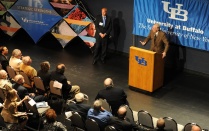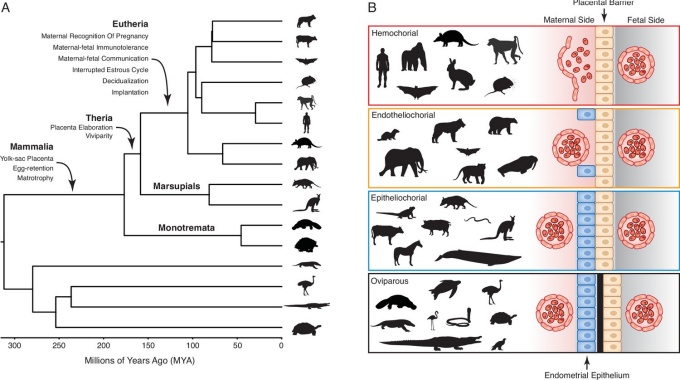Vincent Lynch co-authors paper on expression phylogenies and ancestral transcriptome reconstruction
“Knowing which genes are active among different species during pregnancy tells us about how evolution works,” says senior author Vincent J. Lynch, associate professor of biological sciences, College of Arts and Sciences. “But it also tells us about what makes a healthy pregnancy, and how things might go wrong. We’re finding the genes that establish the right kind of environment for healthy human pregnancies. If those genes are not expressed in the right way, that might give rise to problems.” Read article by Charlotte Hsu.
Figure 1. Evolution and arrangement of the maternal-fetal interface and degree of placental invasion in viviparous Amniotes. The paper is here.
Research News
Study examines how placentas evolved in mammals
By CHARLOTTE HSU
Published July 18, 2022
The fossil record tells us about ancient life through the preserved remains of body parts, like bones, teeth and turtle shells. But how to study the history of soft tissues and organs, which can decay quickly, leaving little evidence behind?
In a new study, scientists use gene expression patterns, called transcriptomics, to investigate the ancient origins of one organ: the placenta, which is vital to pregnancy.
“In some mammals, like humans, the placenta is really invasive, so it invades all the way through the wall of the uterus, into the maternal tissue. In other mammals, the placenta just touches the wall of the uterus. And then there’s everything in between,” says senior author Vincent J. Lynch, associate professor of biological sciences, College of Arts and Sciences.
“So what kind of placentas were early placentas?” he says. “We use gene expression patterns to reconstruct the evolution of the placenta and predict what the placenta of the last common ancestor of eutherian mammals looked like. Our data tells us that this placenta was invasive, and that non-invasive placentas evolved multiple times among mammals. This addresses a 150-year-old mystery. People have been debating what kind of placenta the first one was since then.”
As Lynch explains, all living mammals other than marsupials and egg-laying monotremes are eutherians, which have long pregnancies in which the developing fetus evokes a strong physiological response in the mother.
The research was published on June 30 in eLife. Lynch led the study with first author Katelyn Mika, University of Chicago postdoctoral scholar in human genetics and in organismal biology and anatomy. Camilla M. Whittington and Bronwyn M. McAllan, both at the University of Sydney, are also co-authors.
“Our ability to ask how the placenta might have functioned at different points during its evolution by using the gene expression profiles of currently existing animals to reconstruct the ancestors is a really cool approach and provides us more information on how changing gene expression can contribute to the evolution of a new trait,” Mika says.
To conduct the analysis, the team compared the genes active in the uterus of various mammals during pregnancy. After finding that these gene expression profiles correlated with the degree of placental invasiveness, the scientists used their data to predict what ancestral mammalian placentas looked like.
The study included about 20 species, such as the egg-laying platypus, pouch-bearing marsupials and a range of eutherian mammals that give birth to live young.
The small subset is one limitation of the analysis: The authors write in eLife that research on a larger number of species is needed to help determine the strength of the findings.
Nevertheless, the study makes important contributions in understanding how pregnancy evolved, Lynch says. The results could also benefit modern medicine.
“Knowing which genes are active among different species during pregnancy tells us about how evolution works,” he says. “But it also tells us about what makes a healthy pregnancy, and how things might go wrong. We’re finding the genes that establish the right kind of environment for healthy human pregnancies. If those genes are not expressed in the right way, that might give rise to problems.”
This study was supported by grants from the March of Dimes and the Burroughs Wellcome Fund Preterm Birth Initiative.
Faculty Profile
![Vincent J. Lynch, PhD.]()
Vincent J. Lynch
PhD
Research Interests
Genetics, Genomics and Systems Biology; Evolutionary Biology.
Education
PhD, Ecology and Evolutionary Biology, Yale University, 2008
MS, Ecology and Evolutionary Biology, Yale University, 2005
BS, Biology and Anthropology, University at Albany, SUNY, 2002
Office Hours
Contact vjlynch@buffalo.edu
Research Summary
A major challenge in biology is to determine the genetic and molecular mechanisms responsible for phenotypic differences between species (DevoEvo), particularly mechanisms that underlie the origin of new anatomical structures (‘evolutionary novelties’), biological functions (‘evolutionary innovations’), and that limit biological possibilities (‘developmental constraints’). To explore how evolutionary novelties, innovations, and developmental constraints evolve we combine comparative genomics and experimental methods to deduce the molecular mechanisms that underlie the evolution of pregnancy and animals with extremely long lifespans and large body sizes, and the role evolutionary history plays in our susceptibility to diseases such as preterm birth and cancer.
Current Project
Evolutionary mechanics of adhesion complexes that mediate Amniote hearing
Selected Publications
- VJ Lynch Relaxed constraint and functional divergence of the progesterone receptor (PGR) in the human stem-lineage M Marinić, , PLoS Genetics 16 (4), e1008666
- E Fry, SK Kim, S Chigurapti, KM Mika, A Ratan, A Dammermann, Brian J. Mitchell, Webb Miller, Vincent J Lynch (2020) Functional architecture of deleterious genetic variants in the genome of a Wrangel Island mammoth. Genome Biology and Evolution 12 (3), 48-58
- JM Vazquez, VJ Lynch. Pervasive duplication of tumor suppressors in Afrotherians during the evolution of large bodies and reduced cancer risk. bioRxiv
- M Marinic, K Mika, S Chigurupati, VJ Lynch, Evolutionary transcriptomics implicates HAND2 in the origins of implantation and regulation of gestation length. bioRxiv
- Erin Fry, Sun K. Kim, Sravanthi Chigurapti, Katelyn M. Mika, Aakrosh Ratan, Alexander Dammermann, Brian J. Mitchell, Webb Miller, Vincent J. Lynch (2020) Functional architecture of deleterious genetic variants in the genome of a Wrangel Island mammoth. Genome Biology and Evolution, evz279.
- Vazquez JM, Sulak M, Chigurupati S, Lynch VJ (2018) A Zombie LIF Gene in Elephants Is Upregulated by TP53 to Induce Apoptosis in Response to DNA Damage. Cell Rep. 24(7):1765-1776.
- Sulak M, Fong L, Mika K, Chigurupati S, Yon L, Mongan NP, Emes RD, Lynch VJ (2016) TP53 copy number expansion is associated with the evolution of increased body size and an enhanced DNA damage response in elephants. Elife. 5: e11994.
- Lynch VJ, Nnamani MC, Kapusta A, Brayer K, Plaza SL, Mazur EC, Emera D, Sheikh SZ, Grützner F, Bauersachs S, Graf A, Young SL, Lieb JD, DeMayo FJ, Feschotte C, Wagner GP (2015) Ancient transposable elements transformed the uterine regulatory landscape and transcriptome during the evolution of mammalian pregnancy. Cell Rep. 10(4):551-61.



